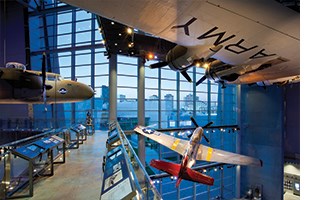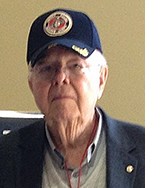Rebecca Davis
AFA Journal staff writer
 The National World War II Museum opened its doors June 6, 2000, after its founder, the late historian Steven Ambrose, had the idea to build it in memory of Andrew Jackson Higgins. Higgins built the boats that were used as landing craft by the United States to win WWII. Higgins Shipyard in New Orleans built some 20,000 of those boats, thus the reason the museum is located in the Big Easy.
The National World War II Museum opened its doors June 6, 2000, after its founder, the late historian Steven Ambrose, had the idea to build it in memory of Andrew Jackson Higgins. Higgins built the boats that were used as landing craft by the United States to win WWII. Higgins Shipyard in New Orleans built some 20,000 of those boats, thus the reason the museum is located in the Big Easy.
“The museum tells the story of the American experience in the war that changed the world,” William M. “Bill” Detweiler, J.D., told AFA Journal. “It tells why it was fought, how it was won, and what it means today so that all generations will understand the price of freedom and be inspired by what they learn. That’s our mission statement.”
Detweiler is the museum’s consultant for military and veterans affairs.
“The museum is a passion for me,” Detweiler said. He has been with the museum since before there was a museum, dating back to his service as national commander of the American Legion (1994-95). During that time he was in a dispute with the Smithsonian Institute over the display of the Enola Gay, a Boeing B-29 Superfortress WWII bomber that became the first aircraft to drop an atomic bomb.
“I got involved on behalf of the American Legion and spent my whole year as national commander trying to defend the courage and honor of the men and women of the war years and to defend President Truman’s decision to drop the bombs to bring the war to a conclusion,” Detweiler explained.
Because of his work, he was elected to the board of the museum a few years later.
Ceremonies
Presently, Detweiler handles all of the outreach and relations dealing with the military on both the local and national levels. This involves special ceremonies presented by the museum as well as assisting with special functions initiated by branches of the military.
“We host major ceremonies on patriotic holidays like Armed Forces Day, Memorial Day, Veterans Day, and the Fourth of July,” Detweiler said.
Plans are still being finalized for this year’s Memorial Day celebration, but in years past it has consisted of a speaker, music by the museum’s Navy band and Marine Corps band, and a POW/MIA ceremony provided by a Jr. ROTC cadet program from one of the local high schools.
“It’s a very elaborate ceremony that’s put on by these high school students in memory of those who have paid the supreme sacrifice and have been lost in war,” Detweiler explained. The Memorial Day program is scheduled to begin at 10:30 a.m. (CT) and is open to the public.
On June 6, the museum is planning a major observance to mark the 70th anniversary of the invasion of Normandy. There is a related event planned almost every day during the week of June 1-8.
Education
The museum reaches out not only to veterans and their loved ones but also to families, schools, students and the community. The purpose of the museum is to help people understand WWII, how it influences the world today and what future generations can learn from it.
“In order to keep young people interested, the exhibits have to be such that they appeal to younger people and that they raise their interests and keep their attention,” Detweiler said.
That’s why the museum always has an ongoing project and is constantly incorporating advanced technology to make the museum relevant both now and in the future.
 One of the most powerful aspects of the museum, according to Detweiler, is a feature presentation titled Beyond All Boundaries that runs daily on the hour. It’s a 4-D film produced by actor Tom Hanks that tells the story of the war in less than an hour.
One of the most powerful aspects of the museum, according to Detweiler, is a feature presentation titled Beyond All Boundaries that runs daily on the hour. It’s a 4-D film produced by actor Tom Hanks that tells the story of the war in less than an hour.
The museum also houses thousands of oral histories, statements from WWII veterans and members of the home front. One of the museum pavilions has been remodeled to look like a train station from the 1940s. Visitors purchase tickets and board a train car that uses technology to take them on a computerized ride through the countryside in order to experience life during the era.
At the museum’s Stage Door Canteen, bands play, the Victory Belles sing, and swing dance lessons are taught on occasion. In the restoration facility, visitors can watch as men and women work to restore a WWII patrol boat similar to the one on which President John F. Kennedy served.
The United States Freedom Pavilion, which opened earlier this year, houses five vintage WWII planes. The planes hang 90 feet in the air, and catwalks allow visitors to walk right up to the planes and look inside them.
There are various hands-on educational projects, events and exhibits like the Classroom Victory Garden Project that teaches elementary students the importance of community during a time of war. The museum holds summer camps for children as well as various activities for families including Night at the Museum, when a child and parent stay in the museum overnight, watch movies and make crafts.
“We’re an educational facility,” Detweiler explained. “We are not a museum of guns and bullets. We’re not about gore. No veteran who has ever seen combat wants to see war or combat again.
“We want families to realize the sacrifices and what it took, what these men and women did, in order to earn and protect the freedoms that we continue to enjoy today,” he said. “We really encourage families who still have a living World War II vet or family member who was working on the home front during World War II to come on in and take a look. It’s worth the visit. It really is.
 May 2014 – He blinked his eyes rapidly and tears began to moisten his 90-year-old cheeks as memories of war flooded his mind.
May 2014 – He blinked his eyes rapidly and tears began to moisten his 90-year-old cheeks as memories of war flooded his mind.
“I guess everybody has those feelings,” World War II veteran Harry Robinson told AFA Journal about his recent trip to the National World War II Museum in New Orleans, Louisiana.
Robinson grew up on a farm in Clay County, Mississippi, and voluntarily joined the U.S. Marine Corps when he was 18 years old. After his enlistment, he rode a train from Jackson, Mississippi, to San Diego, California, and then spent two-and-one-half years overseas. Robinson served as a cook and a baker, so he didn’t experience actual combat other than an invasion of Guam that included his platoon. And he was at home on leave when the bomb was dropped on Hiroshima.
But the war was real; Robinson was a part of it and forever impacted by it.
“I have forgiven, but I haven’t forgotten,” Robinson said. His memories became reality again as he and his family toured the museum.
“I’m so thankful I came back [from war] without a bruise or anything,” he said while fighting back tears. “So many people lost their lives over there. I hope that visitors to the museum recognize the fact that so many gave their lives.”
For more information: nationalww2museum.org or 504-528-1944